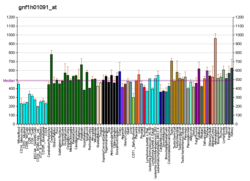Role in embryonic development
Embryonic development is the process where the body plan is created. From studies in vertebrate model systems we can infer the roles of particular genes in human anatomical structures. Wnt3a plays a role in these processes:
Body plan - Torso
Wnt3A patterns a multipotent stem cell population that form neurons, muscles, bones, and cartilage of the torso region. Wnt3a instructs these multipotent stems cells to form muscle, bone, and cartilage progenitors over forming neurons. [8] Wnt3A also regulates the Notch pathway to control the segmentation clock needed for normal torso development [9] [10]
Left-Right patterning
Wnt3a is in a signaling pathway that activates the gene Nodal which is left side signaling determinant [11]
Intestine - Colon
The colon portion of the gastrointestinal tract is completely dependent on Wnt3a and Wnt3a selectively causes the growth of colon progenitors [12]
Blood cells
Wnt3a promotes hematopoietic stem cell self-renewal. Wnt3a is needed for myeloid but not B-lymphoid development at the progenitor level, and affected immature thymocyte differentiation [14]
Brain - Hippocampus
Wnt3a is needed for formation of the hippocampus portion of the brain [15]
Teeth
Wnt3a promotes stem cell properties of dental pulp stem cells [16]
This page is based on this
Wikipedia article Text is available under the
CC BY-SA 4.0 license; additional terms may apply.
Images, videos and audio are available under their respective licenses.




